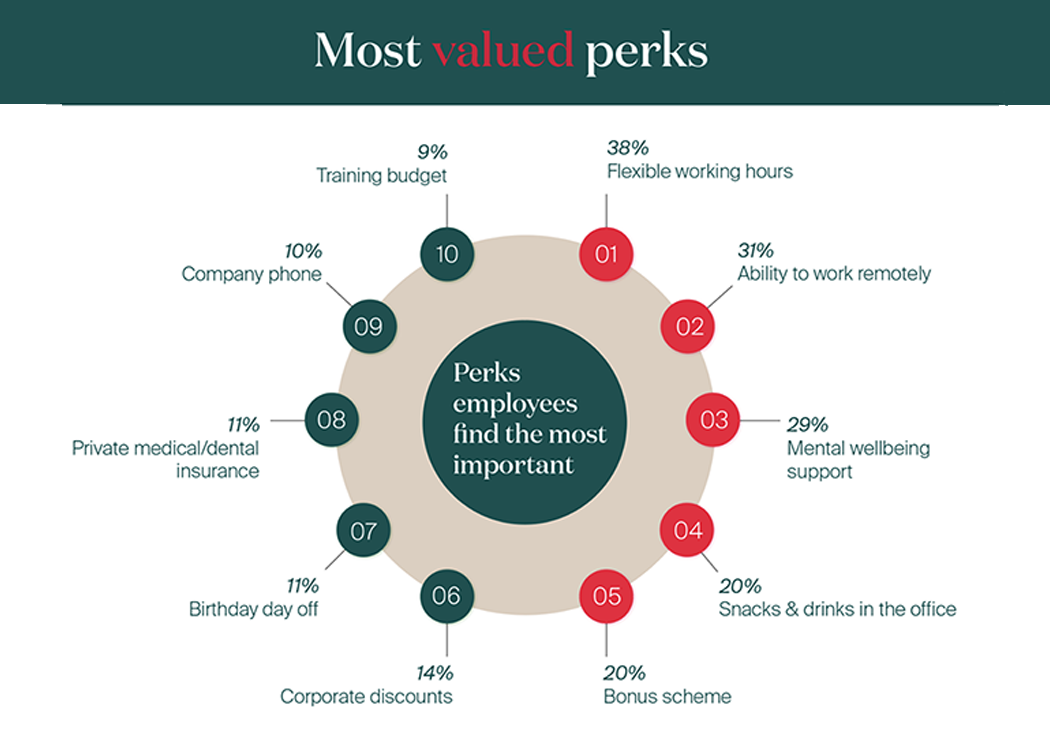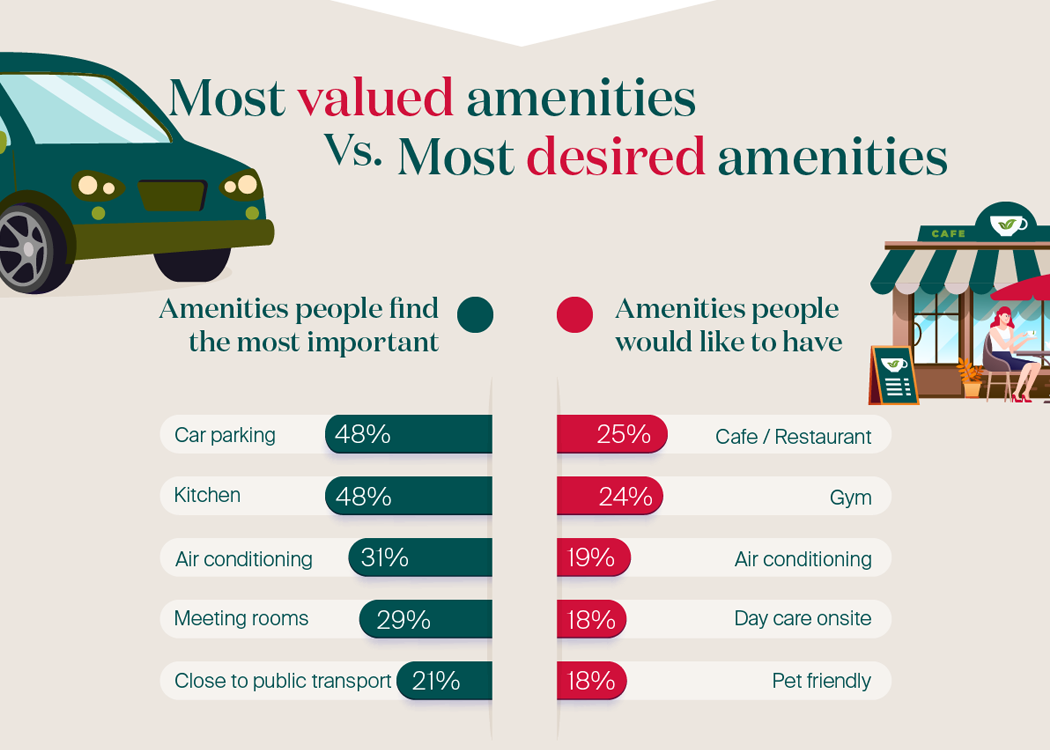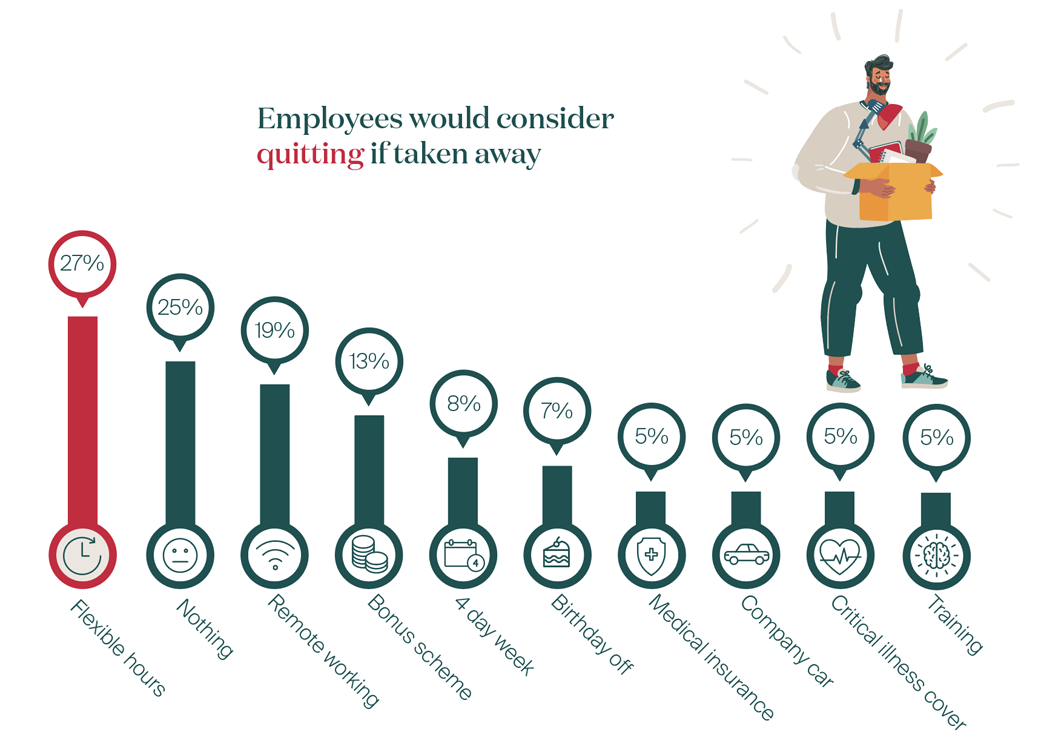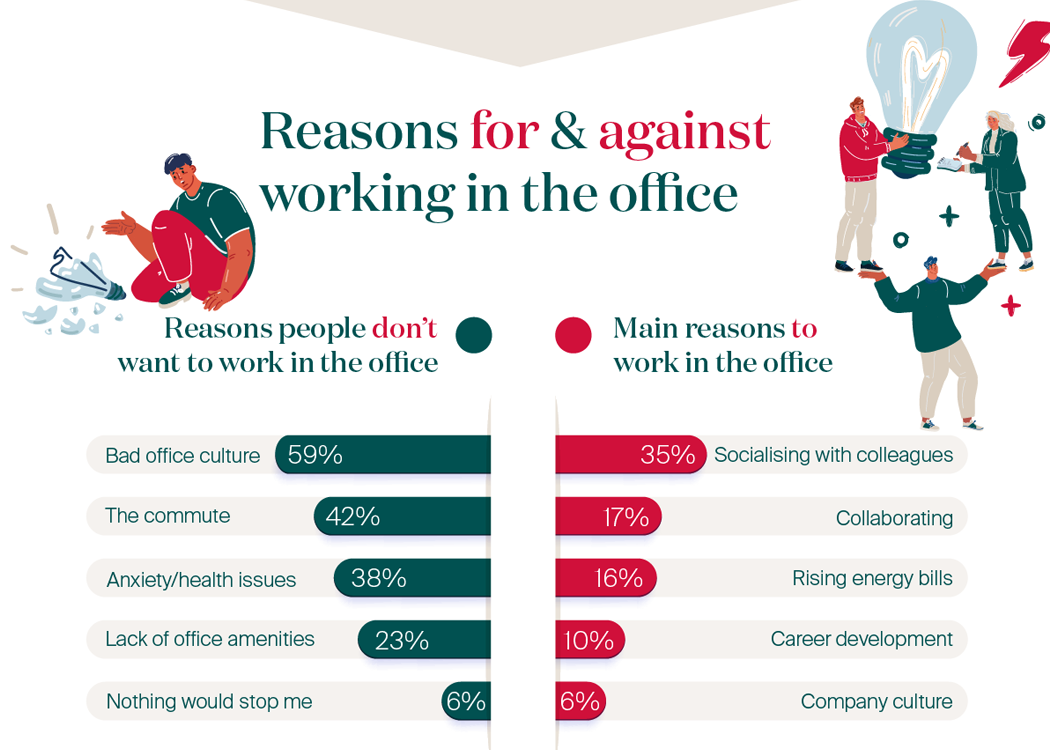
Contact us
We’re experts in finding you the perfect office space at the best price. Ask us to start your search today – it won’t cost you a penny.

In today’s competitive job market, attracting and retaining top talent is a major challenge for many businesses. To hire and keep the best workers, a generous salary is a must, but many employees are also looking beyond their pay. They want a workplace with a positive culture that prioritises their well-being and offers a range of amenities that they cannot get at home.
To meet these needs, many employers are decking their offices out with modern amenities and patching together employee benefits packages that can give them the edge over the competition. However, in many cases, there’s a disconnect between the office perks employers offer and the benefits employees really value.
With that in mind, a Workplace Experience Survey* was conducted to find out what UK-based employees really want from their workplaces - and whether they’re getting it. Here, we share the best employee benefits according to UK workers, discuss the impact office amenities and perks can have, and provide a few recommendations to help you implement them successfully.
The right mix of office amenities and perks can transform the workplace experience and create an environment where employees feel valued, motivated and engaged. When it comes to the amenities on offer, there can be a significant variation from one office to the next, with even the smallest details contributing to a workplace becoming an experience multiplier or detractor.
According to the survey, UK employees are relatively satisfied with their workplaces, with 73% saying they were currently satisfied with their overall workplace experience.
The pandemic played a big part in this by giving employees the chance to step away from the workplace and reset their expectations. Workers who were previously office-based were also able to show that they could be productive from home, and that brought the idea of the office as the only place where people could work into question.
Since then, employers have prioritised amenities that improve their employees’ working lives and enable them to be more productive. That includes amenities that make it easier to work, such as flexible hours, collaborative office layouts and on-site childcare facilities.
Another shift since the pandemic is an acknowledgement that employees are people, not just workers. Employee benefits packages have shifted towards making workspaces more people-centric, which is having a positive impact on workplace culture.
Creating dedicated co-working spaces, incorporating social areas such as cafes and breakout areas, and providing perks such as mental health resources and paid volunteer days, are all proving to be popular among workers. This employee-centric approach is helping to improve the workplace culture and show employees that they are seen, valued and appreciated as people, not just business tools.

The survey shows that the most popular workplace amenities directly support employees and teams in their work habits. And this is a win-win situation, as having a variety of spaces that allow different teams to work in different ways can also help you crack the productivity conundrum.
At its most basic level, employees are no longer willing to spend their days in bland, poorly lit offices with workstations and furniture that don’t meet their needs. Not all employers have the budget for Google-level office amenities, but every office should provide office furniture that keeps workers comfortable, well-supported and free from distractions.
The importance of getting the basics right is illustrated by the third most valued office amenity in the survey, the humble air conditioning system. 31% of the respondents said air conditioning played an important part in creating a comfortable and productive workplace.
One big benefit of the office is that it allows employees to work together, but only if you have spaces that support that kind of activity. Workplace amenities such as roof terraces, breakout areas and meeting rooms can help to bring people together, inspire teamwork and boost creativity.
Well-equipped meeting rooms were one of the most valued office amenities in the survey, with 29% saying it’s a non-negotiable for a modern workspace. However, there should also be a balance, with quiet pods and private booths for those who want to focus on individual tasks.
A further 29% of employees said they valued mental health support and wellness amenities they can access remotely and on-site. Whether they’re working at home or in the office, people want to know that their employer can support them when they need it.
With many workers now prioritising their mental health, they expect to see employee benefits packages and amenities reflect that. An on-site gym was a popular amenity among our respondents, with 24% wanting to be able to work out before, during or after work. Other valued perks include subsidised health classes and mental health care through therapy apps. Workplaces are also prioritising biophilic office design, outdoor spaces, natural light, fresh air and giving workers access to free or subsidised healthy food.
25% of workers would value an on-site cafe or restaurant in their workplace. As well as being somewhere to eat and drink, employees like being able to work away from their desks in an informal setting without having to leave the office entirely. On-site cafes and restaurants can also be very effective co-working spaces and are conducive to informal meetings, collaborative tasks and casual chats with co-workers.
An on-site cafe or restaurant is not a realistic amenity for every business, but a kitchen is. 48% of people said they would value a kitchen space in their office where they could prepare their own food. This is hardly surprising given the rising cost of buying food in shops and eating out.
One in five employees also said that having healthy snacks and drinks available in the office improved the workplace experience. This is a perk all employers can provide and it has real benefits when it comes to health, wellbeing and productivity.
As well as the most valued office amenities, we also asked our respondents for the sort of perks that would stand out in an employee benefits package. The responses here were not surprising, with employees prioritising flexible working and perks that improved their work-life balance.
In a post-pandemic world, flexible working is one of the best employee benefits for attracting and retaining talented workers. Our research found that the ability to work flexible hours was the most desirable office perk, with 38% wanting to be able to work more accommodating office hours above all else.
The next most desirable office perk was the ability to work remotely, with 31% wanting to work from home or away from the office at least some of the time. The UK is the remote working capital of Europe, with UK employees working from home an average of 1.5 days a week. Although office amenities and perks can attract workers back to the office, it’s important to remember that employees are desperate to keep at least some of their flexibility. 27% even said they would consider leaving their jobs if flexible working was removed entirely.

Another workplace perk that ranks highly is the presence of meaningful employee development and training programmes. Most people have career aspirations and want to earn more money, but many also want to take on different challenges and have new experiences.
If employees cannot see where advancement is coming from in their current roles, they’ll simply leave and look for progression elsewhere. This is particularly true of younger workers, with Gen Z employees job hopping after an average of just 1.7 years if there are no opportunities for progression.
Live to work or work to live? For many employees, the pandemic has reset how they view their working lives. They don’t want their work to eat into their evenings or weekends or intrude on the time they spend with their families and friends. That has made work-life balance and time-off initiatives very popular with many workers.
As we’ve already discussed, flexible and remote working are the two employee benefits workers value the most. However, having paid time off to volunteer and better maternity and paternity leave are high on employees’ lists.
The one perk you may not need to worry about too much is the increasingly advertised ‘paw-ternity leave’ for new pet owners. It might be a nice idea, but according to the survey, only 1% of employees value its introduction.
Socialising with colleagues is the main reason why 35% of our respondents want to work from the office, so it makes sense to provide employee benefits that encourage this behaviour. Mentorship schemes, regular social events and office spaces that are designed for employee interaction can all help to build a social work culture.
But creating a social work culture isn’t just about ping-pong tables and endless alcohol, in fact, very few of our respondents said they valued having alcohol provided at work or on team socials. Instead, it’s about providing opportunities for employees to socialise on their own terms. That could be through running clubs, trips to the theatre or regular wellness campaigns.

High-performing employees know their value, so to attract them in the first place and get them to stay, you need to seriously consider what you can give them to compete with those around you, and increasingly, that’s a happy and healthy workplace.
The better your amenities are, then all else being equal, the easier it is to attract and retain top talent. And if you can find and retain the best workers, your business will be more productive and sustainable in the long run.
As the situation stands, nearly half (47%) of the respondents to the survey said their employer doesn’t offer enough work perks, while one in four admitted that the perks they receive have worsened since the pandemic. In an economy where keeping hold of the best talent is a constant challenge, businesses should be wary of getting left behind.
While many businesses might view office amenities and perks as ‘a nice little extra’, the survey found that some perks are so important that employees would consider quitting if they were taken away.
According to the survey, 27% would consider leaving a job if flexible hours were removed and 19% might quit if they could no longer work remotely. The removal of a bonus scheme (13%), four-day week (8%), birthday off (7%), medical insurance (5%) and a company car (5%) also had the potential to prompt a resignation.
It’s also important to consider the reasons why workers might not want to return to the office and the amenities you can potentially put in place to reverse that. 59% of the survey respondents said they didn’t want to go back to the office due to bad company culture and 42% wanted to avoid the commute. 38% said the office caused them anxiety and health issues, while 23% said the office didn’t have amenities they cared about or needed.

Even though some office amenities can be costly, if you are going to ask employees to return to the office more quickly than they might like, you should seriously think about whether your offering is sufficient to help you retain your best staff.
Here are a few examples of companies that are going beyond industry standards to lure people back to the office. They’re also using their office perks and amenities as a powerful hiring and retention tool.

Rather than trying to push workers to return to the office before they might be ready, now is the perfect time to think about what you can offer that they can’t get at home. You can make your workplace a destination through the amenities and services you provide, and here are a few steps to help you get there.
The first step in the process is to understand the amenities and perks your employees value most. While this guide will provide some insight, you need to speak directly to your staff and really listen to their answers to discover the amenities they’d love to see. For example:
- What are they passionate about?
- What are their personal and professional values?
- What spaces do they need to do their best work?
- What technology do they need to do their best work?
- What will make them feel more appreciated in the office?
- What can you do to make their workday better?
Once you know what your employees prioritise, value and need from their workspace, you can start to think about how you’ll put it all in place.
As with any part of your employee benefits package, budgetary constraints will apply. So, the next step is to identify the investment in the office perks and amenities that you can realistically afford. Once you have a shortlist of new amenities, asking employees to vote for their favourites can empower them and give them a stake in that change.
You may not have the resources to make structural changes to your office, but you can still have a big impact. Changing the layout of your office and creating open areas where teams can socialise, relax and work collaboratively can have a profound impact on your workspace and culture for a limited outlay.
With hybrid working becoming the reality for many businesses, companies no longer have to think about how to squeeze as many employees as possible onto endless rows of desks. That gives businesses the room to create more comfortable and collaborative spaces that are specifically designed to support the nature of the tasks they do. Think open lounges, multi-use spaces, breakout areas, communal meetup areas, quiet pods, phone booths, auditoriums and event spaces.
Often, the most collaborative workspaces don’t look like work at all. With a variety of different areas, employees can choose how and where they work and grab a seat in a fluid, comfortable space that suits the task at hand.
These days, an effective office must be virtual first. In a working world where the majority of meetings are either fully virtual or hybrid, you have to make sure your workplace is set up to support this. Employees should be able to connect with anyone from anywhere and have different spaces where everyone can communicate on an equal footing.
To do this, make sure your collaboration spaces and meeting rooms have the necessary audio and video technology to bring remote workers into the room. If you don’t, the office could become a required nuisance for hybrid workers rather than somewhere that offers amenities and perks they can’t get at home.
At Knight Frank, we can help you find flexible office spaces with the amenities and perks to attract and retain the best talent. From collaborative designs to social spaces, we use our experience to find workplaces that are the right match for your needs and budget. We’ll even arrange viewings and negotiate the best deal on your behalf - and our service is free.
*Data Sources: Survey data was collected through Censuswide with 2000 participants across the U.K.